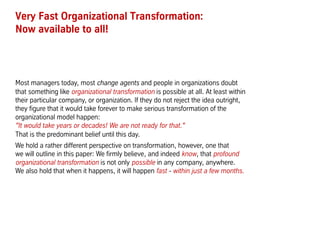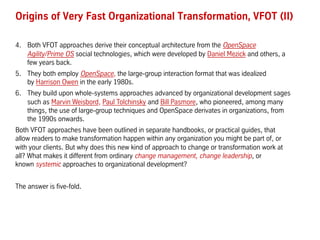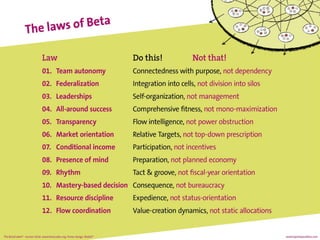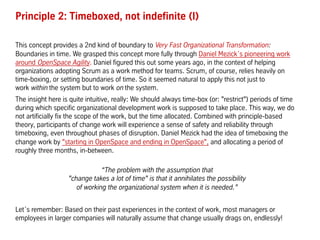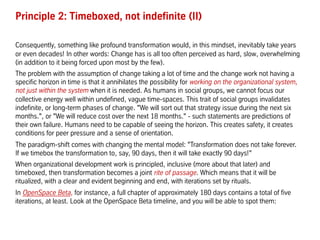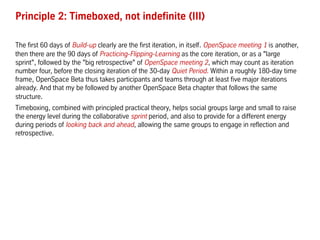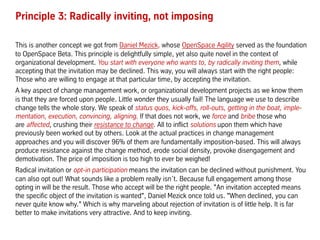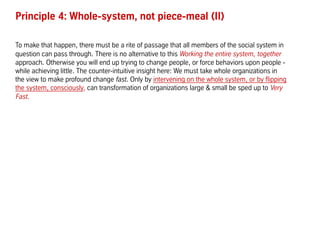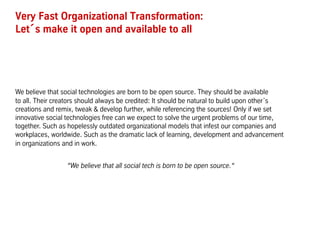Secrets of Very Fast Organizational Transformation (BetaCodex15)
- 1. BetaCodex Network Associates Silke Hermann & Niels Pflaeging BetaCodex Network White Paper No. 15 I January 2019 I betacodex.org/white-papers SECRETS OF VERY FAST ORGANIZATIONAL TRANSFORMATION
- 2. Very Fast Organizational Transformation: Now available to all! Most managers today, most change agents and people in organizations doubt that something like organizational transformation is possible at all. At least within their particular company, or organization. If they do not reject the idea outright, they figure that it would take forever to make serious transformation of the organizational model happen: "It would take years or decades! We are not ready for that." That is the predominant belief until this day. We hold a rather different perspective on transformation, however, one that we will outline in this paper: We firmly believe, and indeed know, that profound organizational transformation is not only possible in any company, anywhere. We also hold that when it happens, it will happen fast - within just a few months.
- 3. Origins of Very Fast Organizational Transformation, VFOT (I) The secret to Very Fast Organizational Transformation, in companies large or small, old or new, local or global, lies in appropriately complex, robust transformation method, or approaches. Such approaches now exist. Not only that: They are open source and thus available to all. This insight was not pulled out of thin air: Instead, the new breed of fast, and highly practical approaches to Very Fast Organizational Transformation such as OpenSpace Beta (developed by the authors of this article in 2018) and OpenSpace Agility (developed in 2015 by Daniel Mezick & others) hinges on several foundational sources and movements that have existed for quite a long time: 1. OpenSpace Beta applies insight from more than 20 years of BetaCodex Network/Beyond Budgeting case research and concept development that started back in 1998 and since then has taken in insight from sciences as varied as business administration, psychology, organizational development and sociology into account. Plus inspiration from the Lean and Agile movements, and original research on Beta concepts such as Relative Performance Systems, Organize for Complexity, Complexitools, Org Physics and Change-as-Flipping. 2. OpenSpace Agility applies insight from Scrum and Agile concepts, implementations and movements. Idealized some 20 years back, Scrum, for instance, has been applied in software development and beyond, worldwide, but it has also often fallen short of expectations, due to feeble, unsystemic, "industrialized" adoption technique. 3. They make use of systems theory and cybernetics advanced by pioneers such as Kurt Lewin, Mary Parker Follett, Eric Trist, W. Edwards Deming, Russell Ackoff, Niklas Luhmann, Ernst Weichselbaum and others, who contributed to our understanding of how to effectively set up & irritate organizational systems.
- 4. Origins of Very Fast Organizational Transformation, VFOT (II) 4. Both VFOT approaches derive their conceptual architecture from the OpenSpace Agility/Prime OS social technologies, which were developed by Daniel Mezick and others, a few years back. 5. They both employ OpenSpace, the large-group interaction format that was idealized by Harrison Owen in the early 1980s. 6. They build upon whole-systems approaches advanced by organizational development sages such as Marvin Weisbord, Paul Tolchinsky and Bill Pasmore, who pioneered, among many things, the use of large-group techniques and OpenSpace derivates in organizations, from the 1990s onwards. Both VFOT approaches have been outlined in separate handbooks, or practical guides, that allow readers to make transformation happen within any organization you might be part of, or with your clients. But why does this new kind of approach to change or transformation work at all? What makes it different from ordinary change management, change leadership, or known systemic approaches to organizational development? The answer is five-fold.
- 5. Principle 1: Principled, not ambiguous (I) The best, most practical organizational theories are principle-based. Very Fast Organizational Transformation cannot be brought about if the underlying content, aim, or practical theory to is not principle-based. The kind of practical theories we are talking about do not promote prescriptions, rules, tools, or mere "best practices". They are not vague or esoteric. They are not mechanistic frameworks. The distinct feature of principle-based theory is that it can at the same time be specific, while not pre-defining a solution before it exists in a specific context, or organization. This is because principles, by nature, must be interpreted by groups of humans. What makes principled approaches so powerful, durable and robust is: They must be constantly socialized, or agreed within the specific social group that wish to adhere to them. Examples of principle-based practical theories, or social technologies are: • Lean, or Total Quality (TQM) - when applying the 14 key principles by W. Edwards Deming, for example • Quick Response Manufacturing (QRM) - when applying the 10 QRM principles by Rajan Suri • Agile - when applying the 4+12 principles from the Agile Manifesto, or the Scrum Guide´s principles • Beta - featuring the 12 principles of the BetaCodex, which were derived, in 2007, from the principles of the Beyond Budgeting model. For illustration, let´s take a look at the principles of the BetaCodex. They are called "laws", and depicted in the overview on the next page.
- 7. Principle 1: Principled, not ambiguous (II) Principle-based practical theories such as Beta, Lean, QRM or Agile come with twists. For instance, they all are indivisable, by nature. Which means that their sets of principles are not menus to choose from. The principles are clearly interdependent, even it it may not appear like that, at first glance. Additionally, in order to agree on principles, or to socialize them, a certain level of awareness of group participants, or a certain level of willingness to face conflict with peers are indispensable. “Principled practical theory allows to be focused & specific, why refraining from the foolishness of pre-defining solutions in complex contexts. Challenges: Such theory is indivisible; it must be constantly socialized.“ In other words: Principles are the only way, and the natural way, to convey the nature of complex systems to social groups, large and small. Which is why manifestos, constitutions, or statements of intent are usually articulated through principles. Principled practical theory will provide an indispensable type of boundary to Very Fast Organizational Transformation, contributing to robustness and reliability of the process, as well as enabling self-organization and emergence.
- 8. Principle 2: Timeboxed, not indefinite (I) This concept provides a 2nd kind of boundary to Very Fast Organizational Transformation: Boundaries in time. We grasped this concept more fully through Daniel Mezick´s pioneering work around OpenSpace Agility. Daniel figured this out some years ago, in the context of helping organizations adopting Scrum as a work method for teams. Scrum, of course, relies heavily on time-boxing, or setting boundaries of time. So it seemed natural to apply this not just to work within the system but to work on the system. The insight here is quite intuitive, really: We should always time-box (or: "restrict") periods of time during which specific organizational development work is supposed to take place. This way, we do not artificially fix the scope of the work, but the time allocated. Combined with principle-based theory, participants of change work will experience a sense of safety and reliability through timeboxing, even throughout phases of disruption. Daniel Mezick had the idea of timeboxing the change work by "starting in OpenSpace and ending in OpenSpace", and allocating a period of roughly three months, in-between. “The problem with the assumption that "change takes a lot of time" is that it annihilates the possibility of working the organizational system when it is needed.” Let´s remember: Based on their past experiences in the context of work, most managers or employees in larger companies will naturally assume that change usually drags on, endlessly!
- 9. Principle 2: Timeboxed, not indefinite (II) Consequently, something like profound transformation would, in this mindset, inevitably take years or even decades! In other words: Change has is all too often perceived as hard, slow, overwhelming (in addition to it being forced upon most by the few). The problem with the assumption of change taking a lot of time and the change work not having a specific horizon in time is that it annihilates the possibility for working on the organizational system, not just within the system when it is needed. As humans in social groups, we cannot focus our collective energy well within undefined, vague time-spaces. This trait of social groups invalidates indefinite, or long-term phases of change. "We will sort out that strategy issue during the next six months.", or "We will reduce cost over the next 18 months." - such statements are predictions of their own failure. Humans need to be capable of seeing the horizon. This creates safety, it creates conditions for peer pressure and a sense of orientation. The paradigm-shift comes with changing the mental model: "Transformation does not take forever. If we timebox the transformation to, say, 90 days, then it will take exactly 90 days!" When organizational development work is principled, inclusive (more about that later) and timeboxed, then transformation becomes a joint rite of passage. Which means that it will be ritualized, with a clear and evident beginning and end, with iterations set by rituals. In OpenSpace Beta, for instance, a full chapter of approximately 180 days contains a total of five iterations, at least. Look at the OpenSpace Beta timeline, and you will be able to spot them:
- 11. Principle 2: Timeboxed, not indefinite (III) The first 60 days of Build-up clearly are the first iteration, in itself. OpenSpace meeting 1 is another, then there are the 90 days of Practicing-Flipping-Learning as the core iteration, or as a "large sprint", followed by the "big retrospective" of OpenSpace meeting 2, which may count as iteration number four, before the closing iteration of the 30-day Quiet Period. Within a roughly 180-day time frame, OpenSpace Beta thus takes participants and teams through at least five major iterations already. And that my be followed by another OpenSpace Beta chapter that follows the same structure. Timeboxing, combined with principled practical theory, helps social groups large and small to raise the energy level during the collaborative sprint period, and also to provide for a different energy during periods of looking back and ahead, allowing the same groups to engage in reflection and retrospective.
- 12. Principle 3: Radically inviting, not imposing This is another concept we got from Daniel Mezick, whose OpenSpace Agility served as the foundation to OpenSpace Beta. This principle is delightfully simple, yet also quite novel in the context of organizational development. You start with everyone who wants to, by radically inviting them, while accepting that the invitation may be declined. This way, you will always start with the right people: Those who are willing to engage at that particular time, by accepting the invitation. A key aspect of change management work, or organizational development projects as we know them is that they are forced upon people. Little wonder they usually fail! The language we use to describe change tells the whole story. We speak of status quos, kick-offs, roll-outs, getting in the boat, imple- mentation, execution, convincing, aligning. If that does not work, we force and bribe those who are affected, crushing their resistance to change. All to inflict solutions upon them which have previously been worked out by others. Look at the actual practices in change management approaches and you will discover 96% of them are fundamentally imposition-based. This will always produce resistance against the change method, erode social density, provoke disengagement and demotivation. The price of imposition is too high to ever be weighed! Radical invitation or opt-in participation means the invitation can be declined without punishment. You can also opt out! What sounds like a problem really isn´t. Because full engagement among those opting in will be the result. Those who accept will be the right people. "An invitation accepted means the specific object of the invitation is wanted", Daniel Mezick once told us. "When declined, you can never quite know why." Which is why marveling about rejection of invitation is of little help. It is far better to make invitations very attractive. And to keep inviting.
- 13. Principle 4: Whole-system, not piece-meal (I) Over the last couple of years it has become somewhat fashionable to promote piece-meal transformation. Piece-meal approaches come in many shapes and varieties. As slicing, for example, applied to individual business units, departments, areas or functions ( "Agile HR"). Pilots and labs are usually no more than slicing. At present, most Lean, TQM, Scrum and Agile are applied by slicing, too, sadly. Slicing, at first glance, seems to offer quick wins or low-hanging fruit. But, as many have learnt the hard way and through expensive efforts, it does not work, and it cannot work, and for a simple reason: One cannot transform departments or functions individually, because we will inevitably end up just dabble within the system, instead of working on the system. Notions of experiments, hacks, or other forms of dabbling of course also fall short of transforming organizational models, or systems in a coherent, and potentially lasting fashion. “Counter-intuitive insight: To produce profound change fast, we must take whole organizations in the view - not slices, bits or pieces. By intervening on the whole system, or flipping the system, we can speed up transformation of organizations large & small to Very Fast.” What piece-meal transformation, as well as tools, rules & frameworks do not take into account is that actual transformation requires: first producing insight among members of the system, or change of mental models of many, then working the system, together, for behavioral patterns and interactions to actually adapt and change.
- 14. Principle 4: Whole-system, not piece-meal (II) To make that happen, there must be a rite of passage that all members of the social system in question can pass through. There is no alternative to this Working the entire system, together approach. Otherwise you will end up trying to change people, or force behaviors upon people - while achieving little. The counter-intuitive insight here: We must take whole organizations in the view to make profound change fast. Only by intervening on the whole system, or by flipping the system, consciously, can transformation of organizations large & small be sped up to Very Fast.
- 15. Principle 5: All at once, not stacked (I) Another dimension of whole-system approaches is to include everyone, at the same time, early-on. This is very different than "scaling", phasing, or stacking involvement. While change management relies on having solutions developed behind closed doors first by chosen ones, then "rolling them out", Very Fast Organizational Transformation does the opposite: Inviting everyone at once to work the whole organization, together, based on a principled approach and through timeboxed iterations. Question is: How do you get everyone involved & engaged at once? Answer: You need an additional piece of social tech: An engagement model. The engagement model that both OpenSpace Beta and OpenSpace Agility employ is of course the social technology called OpenSpace, which was already envisioned by Harrison Owen way back in the early 1980s, but which only now returns to its home turf of organizational development. OpenSpace itself is based on a total of five principles - it combines extreme simplicity of setup with radical self-organization. And it easily scales to a few thousand participants for a single event. “Question is: How do you get everyone involved & engaged at once? Answer: You need an additional piece of social tech: An engagement model.” Here is what OpenSpace looks like, articulated through 5 principles, of which one is called "the one law":
- 17. Principle 5: All at once, not stacked (II) Involvement of everyone up-front who accepts the invitation through an opt-in engagement model has several functions: It allows to build a shared mindset quickly, and then involve all the right people immediately to perform many, many interventions on system and interactions all at once. This is where the speed in VFOT comes from: Organizations exist so that many can share in the work. Why not develop the organization together, too? Involvement of course works best when a couple of conditions are met, i.e. when the time-frame is restricted and when the effort is focused on a specific, principled purpose. Humans can commit more easily then. That is the very opposite of getting in the boat, convincing, aligning, or hustling people into action. In this sense, Very Fast Organizational Transformation attempts the opposite of aiming at quick wins. While quick win-approaches will always push the great achievement, "the real transformation” into the future, usually resulting in "some quick wins and then nothing", VFOT adheres to the old Yoda adage: Do, or do not - there is no try! So in order to get VFOT, you must really, really want it, first.
- 18. Very Fast Organizational Transformation: Let s make it open and available to all We believe that social technologies are born to be open source. They should be available to all. Their creators should always be credited: It should be natural to build upon other´s creations and remix, tweak & develop further, while referencing the sources! Only if we set innovative social technologies free can we expect to solve the urgent problems of our time, together. Such as hopelessly outdated organizational models that infest our companies and workplaces, worldwide. Such as the dramatic lack of learning, development and advancement in organizations and in work. “We believe that all social tech is born to be open source.“
- 19. 19 Find all BetaCodex Network white papers on betacodex.org/white-papers and on Slideshare. The BetaCodex Network white papers so far
- 20. www.betacodexpublishing.com BetaCodex Publishing books Organize for Complexity Niels Pflaeging 2015 Also available in German, Portuguese, Turkish Complexitools Niels Pflaeging I Silke Hermann 2019 Also available in German OpenSpace Beta Silke Hermann I Niels Pflaeging 2018
- 21. www.betacodex.org Get in touch with us for more information about Beta and BetaCodex transformation. The illustrations from this paper are available as posters from www.OpenSpaceBeta.com Niels Pflaeging Niels.pflaeging@RedForty2.com Silke Hermann Silke.Hermann@RedForty2.com


